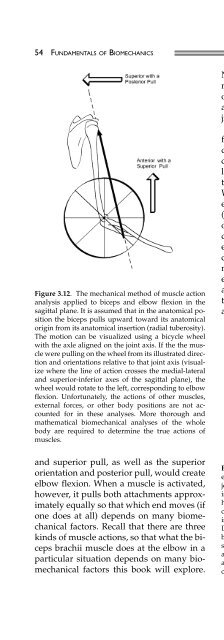Fundamentals of Biomechanics
Fundamentals of Biomechanics
Fundamentals of Biomechanics
You also want an ePaper? Increase the reach of your titles
YUMPU automatically turns print PDFs into web optimized ePapers that Google loves.
54 FUNDAMENTALS OF BIOMECHANICS<br />
Figure 3.12. The mechanical method <strong>of</strong> muscle action<br />
analysis applied to biceps and elbow flexion in the<br />
sagittal plane. It is assumed that in the anatomical position<br />
the biceps pulls upward toward its anatomical<br />
origin from its anatomical insertion (radial tuberosity).<br />
The motion can be visualized using a bicycle wheel<br />
with the axle aligned on the joint axis. If the the muscle<br />
were pulling on the wheel from its illustrated direction<br />
and orientations relative to that joint axis (visualize<br />
where the line <strong>of</strong> action crosses the medial-lateral<br />
and superior-inferior axes <strong>of</strong> the sagittal plane), the<br />
wheel would rotate to the left, corresponding to elbow<br />
flexion. Unfortunately, the actions <strong>of</strong> other muscles,<br />
external forces, or other body positions are not accounted<br />
for in these analyses. More thorough and<br />
mathematical biomechanical analyses <strong>of</strong> the whole<br />
body are required to determine the true actions <strong>of</strong><br />
muscles.<br />
and superior pull, as well as the superior<br />
orientation and posterior pull, would create<br />
elbow flexion. When a muscle is activated,<br />
however, it pulls both attachments approximately<br />
equally so that which end moves (if<br />
one does at all) depends on many biomechanical<br />
factors. Recall that there are three<br />
kinds <strong>of</strong> muscle actions, so that what the biceps<br />
brachii muscle does at the elbow in a<br />
particular situation depends on many biomechanical<br />
factors this book will explore.<br />
Notice that the tension at both ends <strong>of</strong> a<br />
muscle <strong>of</strong>ten might not be the same because<br />
<strong>of</strong> the force transmitted to nearby muscles<br />
and extramuscular connective tissue (Huijing,<br />
1999; Maas et al., 2004).<br />
While the biceps is clearly an elbow<br />
flexor, this analysis assumes quite a bit and<br />
does not take into consideration other muscles,<br />
other external forces, and the biarticular<br />
nature <strong>of</strong> the biceps. The long head <strong>of</strong><br />
the biceps brachii crosses the shoulder joint.<br />
What if the movement <strong>of</strong> interest was the<br />
eccentric phase <strong>of</strong> the pull-over exercise<br />
(Figure 3.13), where the shoulder was the<br />
origin because the elbow angle essentially<br />
did not change while shoulder flexion and<br />
extension were occurring? It is not entirely<br />
clear if the long head <strong>of</strong> the biceps is in isometric<br />
or concentric action in this pull-over<br />
exercise example. Biomechanical data and<br />
analysis are necessary to determine the actual<br />
actions <strong>of</strong> muscles in movement. There<br />
are even cases where muscles accelerate a<br />
Figure 3.13. In the eccentric phase <strong>of</strong> the pullover exercise,<br />
the motion primarily occurs at the shoulder<br />
joint, with the elbow angle remaining unchanged. The<br />
isolated mechanical method <strong>of</strong> muscle action does not<br />
help in this situation to determine if the long head biceps<br />
(crossing both the elbow and shoulder joints) is<br />
isometrically active, concentrically active, or inactive.<br />
Do you think a biarticular muscle like the biceps can<br />
be doing two kinds <strong>of</strong> muscle actions at once? We will<br />
see later that extensive kinetic biomechanical models<br />
and EMG research must be combined to determine the<br />
actual action <strong>of</strong> muscles in many movements. Image<br />
courtesy <strong>of</strong> VHI Kits, Tacoma, WA.






